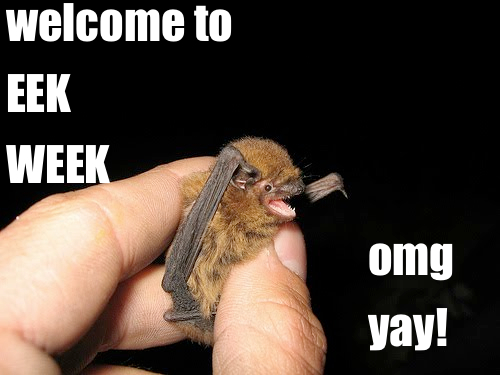

It’s that time of year, when the world falls in love with bats, snakes, spiders and other eek creatures for a few days. So let’s celebrate Eek Week! As eek decor reaches critical mass, it’s a good time to learn more about these creatures and why you can see them as helpful and cool, not scary and gross.
So here are five ways to help. A couple of these are cool projects trying to raise money, but most will cost you nothing but your time. Please consider getting involved this week.
As a courtesy to bug-phobes, some of the more lurid images in this post will be hidden until and unless you press this button.
SHOW
Hunting ZomBees
Honeybees are fighting battles on multiple fronts, from climate change and pesticides to fungal diseases and invasive parasites. This project studies the latter, specifically a parasitic fly called Apocephalus borealis. The tiny insect parasitizes bumblebees, but in 2012 a group of researchers in California found it also attacks the western honeybee. This “zombie fly” pursues a bee, lands on its abdomen and lays its eggs inside. The bees die within a couple days and the fly larvae pupate, leaving the bee carcass behind.
Bees that have been attacked will leave their hives at night, becoming living dead “zombees,” researchers say. Now scientists are trying to determine where this happens, and they need your help. You can become a ZomBee hunter with some simple training, and help determine where the zombie fly is parasitizing honeybees in North America. Learn more here.

Be a Bat Detective
This year-old Zooniverse project lets citizen scientists catalog recorded bat calls. Humans are skilled at hearing (and seeing) the difference between bat calls and non-bat sounds, and the sequences of particular calls. The goal is to create an algorithm that can extract information from bat sounds, allowing researchers all over the world to learn more about bats. It works by displaying a spectrogram, a visual representation of a sound pattern, along with bat sounds, so you can categorize them. Learn more about it here.
Where is My Spider?
Just like any other creature, changing climate conditions and other environmental factors will affect where spiders live in the future. Determining where they live now will help scientists understand these changes. Just by taking pictures of spiders and sending your location, you can help the Explorit Science Center in California learn which climates certain spiders live in. This will help ecologists track the distribution of spiders over time. Go here to sign up.

Wiring the Hive
This project will help students at Georgia Tech (mascot: yellow jackets!) put RFID tags on their honeybees, and buy a thermal camera to monitor their activity. Students are investigating how urban environments affect bee behavior, and this technology will help them monitor the bees’ activities up-close. Wiring the hives will also allow the researchers to set up a BeeCam. It may not be Panda Cam, but it’s cool nonetheless. Go here to make a donation.
Bats and UV Light
Finally, you can help out bats by funding a project I mentioned earlier this month. Researcher John Gumbs is trying to use ultraviolet light to diagnose white-nose syndrome, which is decimating bat populations all over the country. He only has five days to make his goal — go here to learn more, or make a donation!

Hat tip to SciStarter for the bee and spider projects.
